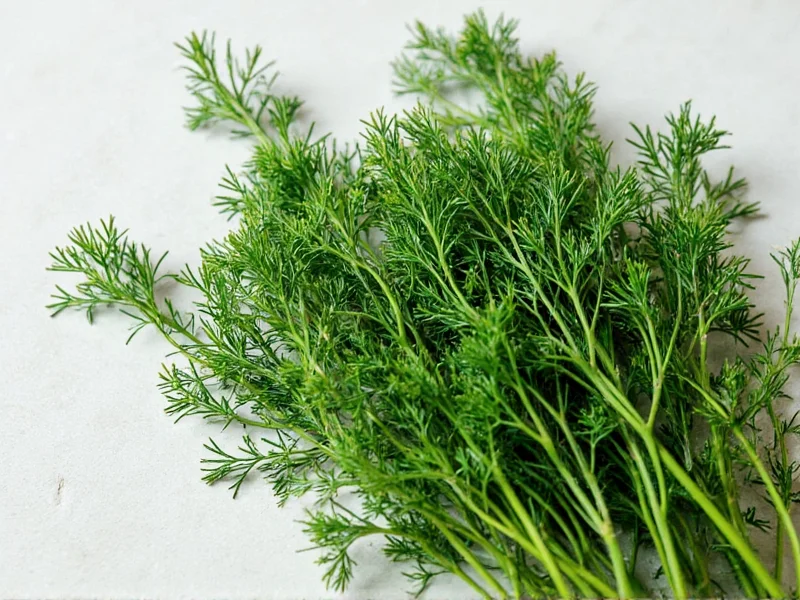Understanding the proper conversion between fresh and dried dill is essential for achieving balanced flavors in your cooking. Many home chefs make the mistake of using equal amounts when substituting, resulting in either under-seasoned or overpowering dishes. The difference stems from the fundamental change in composition when dill loses its moisture content during the drying process.
Why Fresh and Dried Dill Aren't Interchangeable
Fresh dill contains approximately 85-90% water, while dried dill has only about 10% moisture remaining. This dramatic reduction concentrates the essential oils and flavor compounds, making dried dill significantly more potent by volume. The drying process also alters certain volatile compounds, creating subtle but noticeable differences in flavor profile.
When you use dried dill in place of fresh without adjusting the quantity, you're actually adding three times more concentrated flavoring agents to your dish. This explains why many recipes become unpleasantly strong when substitutions aren't properly calibrated.
Flavor Profile Differences
Fresh dill offers bright, grassy notes with citrus undertones and a delicate aroma. The flavor is more nuanced and subtle, making it ideal for finishing dishes or using in raw preparations like salads and dips.
Dried dill develops earthier, more concentrated flavors with slightly muted citrus notes. The drying process intensifies certain compounds while diminishing others, resulting in a more robust but less complex flavor profile. Dried dill works best when added early in the cooking process to allow its flavors to infuse throughout the dish.
Practical Conversion Guide
Use this reference table for accurate substitutions in your recipes. Remember that these measurements refer to properly stored, high-quality dried dill. Old or poorly stored dried herbs lose potency over time.
| Fresh Dill | Dried Dill | Best For |
|---|---|---|
| 1 cup chopped | 1/3 cup | Dill salad, tzatziki, fish toppings |
| 1/4 cup | 1 tablespoon | Dressings, sauces, potato salad |
| 1 tablespoon | 1 teaspoon | Cooking applications, soups, stews |
| 1 teaspoon | 1/4 teaspoon | Finishing touches, delicate dishes |
When to Use Each Form
Fresh dill shines in applications where its delicate flavor can remain prominent:
- As a garnish for finished dishes
- In cold preparations like salads, dips, and dressings
- With seafood, particularly salmon and other fatty fish
- In vinegars and oils where fresh flavor infusion is desired
Dried dill works best when you need consistent flavor throughout cooking:
- In soups, stews, and braises where long cooking times are involved
- In spice blends and rubs
- When making pickles or preserved foods
- In baked goods like dill bread or crackers
Storage Tips for Maximum Flavor Retention
Proper storage significantly impacts the potency of dried dill. Store dried dill in an airtight container away from light, heat, and moisture. A dark cupboard works better than a refrigerator, which introduces humidity that degrades quality.
Dried dill maintains optimal flavor for 6-12 months when stored properly. After this period, it doesn't spoil but gradually loses potency. Test older dried dill by rubbing a small amount between your fingers and smelling it—if the aroma is weak, you'll need to use slightly more than the standard conversion ratio.
Avoiding Common Substitution Mistakes
Chefs often make these errors when converting dill fresh to dried:
- Equal substitution - Using the same volume of dried dill as fresh dill results in overpowering flavors
- Ignoring timing - Adding dried dill at the end of cooking rather than early when it needs time to rehydrate and release flavors
- Using old dried herbs - Not compensating for potency loss in older dried dill
- Overprocessing - Grinding dried dill too finely, which releases oils too quickly and causes flavor to dissipate
For best results with dried dill, add it early in the cooking process to allow time for the flavors to develop. If using in cold applications, consider steeping the dried dill in a small amount of warm liquid first to help release its flavors before incorporating into the final dish.
Maximizing Flavor in Your Dishes
Understanding dill fresh to dried conversion ratios is just the beginning. To truly master herb usage in cooking:
- Taste as you go when substituting—start with less dried dill than you think you need
- Consider the dish's cooking time—longer cooking requires less dried dill as flavors concentrate
- Pair dried dill with fats (oil, butter, cream) to help extract and distribute its flavors
- For delicate dishes, use half the standard conversion ratio and adjust to taste
Remember that personal preference plays a role in seasoning. Some people prefer more pronounced dill flavor, while others prefer subtlety. The conversion ratios provide a reliable starting point that you can adjust based on your taste preferences and the specific requirements of your recipe.











 浙公网安备
33010002000092号
浙公网安备
33010002000092号 浙B2-20120091-4
浙B2-20120091-4